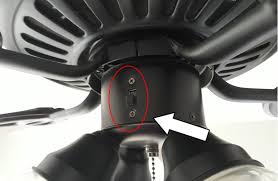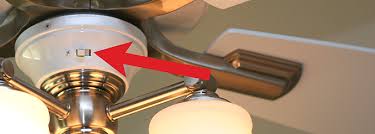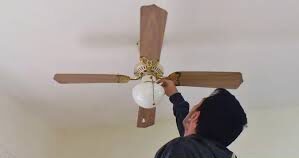Why Does My Ceiling Fan Have A Reverse Switch?
Ceiling fans are great to have during those Summer months, but what most people don’t know is that they have a setting for Winter too. Changing the direction that your ceiling fan spins can help keep you more comfortable during all months of the year. Not only that, but you can give your furnace or air conditioner a break.
Summer Ceiling Fan
In the Summer, make sure your ceiling fans are rotating counterclockwise. This direction pushes cool air down to the floor, which is where you are. Have you ever noticed how cool wind can be when you are hot? That is because the cool air meets the perspiration on your skin and creates the wind-chill effect. Setting your ceiling fan to spin counterclockwise in the Summer months will help you save a little money by reducing how much you use your air conditioner. Ceiling fans are not restricted to indoor use either. You can add a cooling effect to your outdoor patio by adding an outdoor ceiling fan
Winter Ceiling Fan
In the Winter your ceiling fans should spin clockwise at a low speed to pull the cool air up and away from you. This updraft pushes warm air down along the walls back down to the floor. Hot air rises, but by pulling cooler air up the warmer air needs somewhere to go so it is pushed back down to where you are. This allows you to save money by reducing your furnace running time. One exception to this is if your ceiling fan is mounted on a two-story ceiling. The fan may to too high to make a difference and can stay in the counterclockwise rotation all year around.

Ceiling fan switch direction – up or down?
Locate the direction switch on the motor housing (in some cases, the switch may be located inside the switch housing or switch cup), and flip the switch in the opposite direction. Directional switches may move vertically (up and down) or horizontally (side to side from left to right).
Note: If you do not find a switch on the motor housing and you do not have a remote, please jump to how to change your blade pitch below.
How To Switch Your Ceiling Fan Blade Direction
For vertical direction switches, flip the switch down for downward airflow or flip the switch up for upward airflow.
For horizontal direction switches, flip the switch to the left for downward airflow or flip the switch to the right for upward airflow.
Use the steps below to change the direction of your ceiling fan:
- Shut off the ceiling fan and wait for the blades to come to a complete stop
- Using a ladder or step stool to reach the motor housing, locate the direction switch
- Flip the switch in the opposite direction
- Step down and turn the ceiling fan back on
- Verify the ceiling fan blades are moving in the right direction

Counterc lockwise fan direction for cool summer savings
In the summer, ceiling fans should rotate counterclockwise to push cool air down to the floor. The cool air evaporates perspiration and creates a wind chill effect, which makes you feel cooler without affecting the room temperature. This allows you to set the thermostat at a higher temperature without forfeiting comfort.
So, how you can you tell if your ceiling fan direction is set for summer? Turn on the fan, stand directly under the fan blades and watch the blades rotate. The blades should move from the top left, then down to the right, and then back to the top. Looking for a more telltale sign? You should feel air movement while standing under the fan. If you do not feel air movement, the fan is spinning clockwise.
Cooling comfort is just a small benefit of using a ceiling fan in the summer. Homeowners who use ceiling fans during the summer can save as much as 40 percent on air conditioning bills.
Don’t confine your comfort to the indoors. If you enjoy spending a sunny summer afternoon outside, choose an outdoor ceiling fan for your patio, porch, or favorite outdoor spot. An outdoor fan not only helps you keep cool, but it also keeps insects and other unwanted pests at bay.
CLOCKWISE FAN DIRECTION FOR WARM WINTER COMFORT
In the winter, ceiling fans should rotate clockwise at a low speed to pull cool air up. The gentle updraft pushes warm air, which naturally rises to the ceiling, down along the walls and back the floor. This makes a room feel warmer, which allows you to lower the thermostat temperature and decrease the use of heating devices. Homeowners who use ceiling fans during the winter can save as much as 15 percent on heating bills.
So, how can you tell if your ceiling fan direction is set for winter? Turn on the ceiling fan, stand directly under the fan blades and watch the blades as they rotate. The blades should move like a clock’s hand – from the top to the right, then down to the left, and back to the top) at a low speed to pull cool air up.
Exception: If your ceiling fan is mounted on a two-story cathedral or a vaulted ceiling, the fan is too high to create a discernible wind chill, and therefore, can stay in a counterclockwise setting all year round.

Why not just raise the thermostat?
Every time you raise the temperature on the thermostat, you raise the price of your energy bill. In fact, lowering the thermostat by just one degree saves you around 3% on your gas bill, so relying on the direction of ceiling fans to produce heat will help you save energy and money in the long run.
Once you do decide to reverse the ceiling fan direction, be sure to adjust your thermostat accordingly. You’ll no longer need to set the temperature as high now that you’re being energy-efficient! As always, when you leave the room, be sure to treat the ceiling fan as you would any other electric device and turn it off when it’s not in use.
Now that you know this tip, it all comes down to remembering to do it! According to SplendidFans a great way to remind yourself to set the direction of ceiling fans in reverse is to do it every Daylight Saving Time. Because Daylight Savings falls on dates in the spring and fall, these are the perfect times to adjust your ceiling fan to move in the reverse direction before the peak of winter, and then back to the forward direction before the heat of summer hits.
Changing the direction of ceiling fans in your home is a simple solution to saving you money and helping you find comfort in your home even during the coldest of months!
What is the purpose of the reverse switch on ceiling fans?
ceiling fans are intended to circulate air “up” or “down”, depending on the seasons. When trying to keep the lower (‘living space’) portion of a room cool, pulling air “up” keeps the warmer air “up” and cooler air “down”. When trying to keep the lower portion warm, pushing air “down” ensures the warm air remains low, as warm air naturally tends to rise, of course.
It’s really all in the “pitch” (angle) of the fan paddles (blades). As they rotate, they slice through the air, ‘pulling’ or ‘pushing’ it up or down.
Keep in mind also that these literal sounding “up” and “down” air circulation terms are not necessarily all that precise. In other words, each space, as well as adjoining spaces, plays a role in exactly how air circulates throughout a particular room layout.
With that in mind, there might be times when pulling warm air “up” during heating season, or pushing it “down” during cooling season is prudent, as it all has bearing on the overall circulation